Jesse Mulligan speaks to Planet hunter, Associate Professor Michael Albrow, about the discovery of seven new planets.

This NASA poster imagines what a trip to TRAPPIST-1e might be like. Photo: NASA-JPL/Caltech
NASA announced today the discovery of seven Earth-sized planets that orbit a star just 40 light years (235 trillion miles) away [that’s relatively close in space talk].
Three of them are in what is described as the "habitable zone" where a rocky planet is most likely to have liquid water, and therefore life could possibly exist.
According to NASA, all seven planets could have liquid water – key to life as we know it – under the right atmospheric conditions, but the chances are highest with the three in the habitable zone.
“This discovery could be a significant piece in the puzzle of finding habitable environments, places that are conducive to life,” said NASA’s Thomas Zurbuchen.
“Answering the question ‘are we alone’ is a top science priority and finding so many planets like these for the first time in the habitable zone is a remarkable step forward toward that goal.”
***
Planet hunter, Associate Professor Michael Albrow, a senior lecturer in astronomy at the University of Canterbury spoke to RNZ’s Jesse Mulligan about just how significant this find is:
What do we know about this star they are orbiting?
We know it’s a very small and cool star. So, if we think of our solar system, the sun is by far the biggest object and Jupiter is maybe 1000 times less massive. This star is only about the size of Jupiter. [FYI: more than 1300 earths would fit inside Jupiter, so again, space talk] About 10 times the diameter smaller [than our sun]. It’s like comparing a golf ball with a basketball.
So the actual size is 10 times smaller than the sun, but the mass is 1000 times smaller, which means there’s not so much going on in the body of the star?
Yes, that’s right.
Presumably that affects how close a planet needs to be to be in the habitable zone?
That’s right. Because the star is so small and cool [NASA describes the star, TRAPPIST-1 as being an "ultra-cool dwarf"], it doesn’t put out as much radiation, or light, as our sun does, so that means the planets can be much closer in, but it can still be roughly the same temperature as the earth.
What are the prospects for these planets to be able to sustain life?
There are a whole lot of factors that go into that, and scientists haven’t sorted all of them out yet - maybe because we’ve never detected life on any planet other than our own. But one thing everybody agrees with, more or less, is that something you need is for water to be able to exist in a liquid state. If your planet is too far away from the sun all the water would be frozen and if it’s too close all the water would be vapourised to steam, so we have this notion called the ‘habitable’ or ‘goldilocks zone’ and that’s the zone around a star where water would exist in a liquid form and planets would be capable of having oceans, for instance.

This artist's concept shows what each of the TRAPPIST-1 planets may look like, based on available data about their sizes, masses and orbital distances. Photo: NASA-JPL/Caltech
What are the chances that water will be on them?
I don’t know the answer to that question. Things are in the right place for that to happen, but we don’t have measurements yet that will show it. That doesn’t mean we’ll never get such measurements… Some time in the future we will probably be able to detect whether they have atmospheres.
They’re actually quite close - 40 light years away - close enough that we might have seen them before if we were looking for the right thing?
That’s right to some extent... Only in the last decade or do have we had the technology to make these kinds of measurements but the star has been there and the planets have been whizzing around it, so it could have been detected some years ago. But, you know, there are a lot of stars in the sky so it takes time to track them all down.

This illustration shows the possible surface of TRAPPIST-1f, one of the newly discovered planets in the TRAPPIST-1 system. Photo: NASA/JPL-Caltech
How rare is it these days to find a little cluster of planets like this?
This is very rare. Nowadays we know of several thousand stars that have planets around them, but the vast majority of those planets are large like Jupiter, and they’re also often found very close to their stars where it would be too hot to sustain life. Our detection of Earth-mass planets is very rare. We think they’re probably rather common, but they’re very hard to detect, and this was really exciting to detect so many in a star that’s not that far away by astronomical standards.
We had a good chat last year and I think you explained to me then that part of the problem is we're a little planet next to a very, very bright star and it’s hard to see what’s going on from that perspective.
That’s right, I think there’s no hope in being able to directly image these planets, but the way they’re detected is that they orbit their star, and when they pass in front of it they block out some of the light for a certain amount of time… We do have the technology now being developed that we can perhaps measure whether there are gases like water vapour in the atmosphere. It’s probably something we’ll develop in the next decade or two.
So we’re definitely one step closer today to discovering life beyond earth?
That’s right, it’s a huge step closer. For some time we’ve been inferring that as we go to smaller and smaller planets it seemed like they were more common, but because they were so hard to detect we didn’t really have good evidence that there were very many Earth-sized planets. But this really bumped the numbers up… and the fact that they're all orbiting one star is really interesting.
***
You can check out the prof talking about his own research here:


